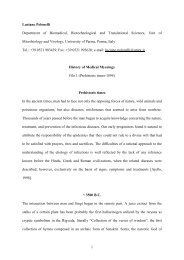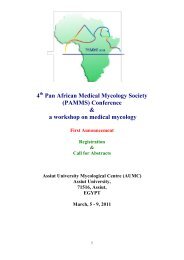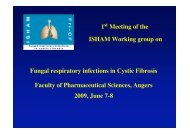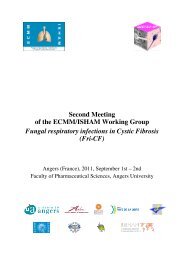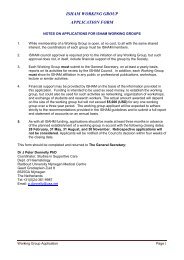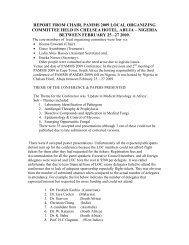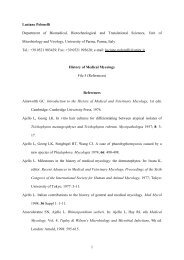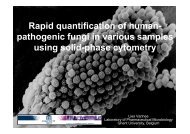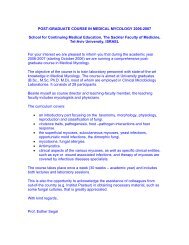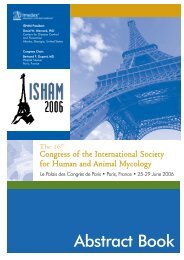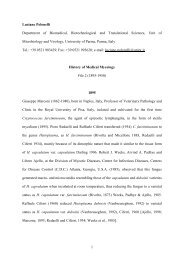Memoria CD.indd - ISHAM
Memoria CD.indd - ISHAM
Memoria CD.indd - ISHAM
Create successful ePaper yourself
Turn your PDF publications into a flip-book with our unique Google optimized e-Paper software.
P. brasiliensis growth and infective propagulaproduction in clayey and sandy soilE. Bagagli 1 , Terçarioli G.R. 1 , Barrozo L.V. 21 Departamento de Microbiologia e Imunologia,Instituto de Biociências, Unesp, Botucatu, SP, Brasil.2 Faculdade de Filosofia, Letras e Ciências Humanas, USP, São Paulo – Brasil.e-mail: bagagli@ibb.unesp.brAlthough the existence of some controversies, including the hypothesis that P. brasiliensis occurs inheterothermic animals from fresh water environments (Conti-Diaz, 2007), several pieces of evidencepoint to the soil as its main saprobic habitat. In such environment, the fungus must develop andproduce the infective propagula, the arthrospores or simply conidia. The influence of soil texture andchemical composition in fungus development has been little understood. For example, in BotucatuPCM endemic area, while infected armadillos occur in places containing both sandy and clayey soiltype (Bagagli et al. 2003), the human infection seems to be more prevalent in regions where clayeysoil is more abundant (Simões et al, 2004).We have then observed experimentally that the fungal growth was similar in clayey and sandy soiltextures, and that no growth occur when the soil composition contained high values of ExchangeableAluminum (H+Al) and, consequently, a low Bases Saturation value (V%). The fungal growth washigher in soil saturated with water than in soil with moderate humidity, determined by its field capacity(FC). There was no growth in low humidity soil, such as in the one that contains only half of its FC. Itwas also observed that some isolates did not produce conidia while in others the conidia productionwas relatively high, mainly when the fungus was grown on relatively poor substrates containing soilextracts, and that this feature (conidia production) could be associated with the genetic group of theisolates (abundant in S1 and rare in PS2 genetic group), according to Terçarioli et al, 2007.In conclusion, the major incidence of paracoccidioidomycosis in clayey soil areas may be due tothe widespread use of this soil type in agricultural activity than sandy soil. High humidity is necessaryfor P. brasiliensis develop in soil. Some soil conditions, in particular those that contain elevatedExchangeable Aluminum (H+Al) may inhibit or limit fungus growth. The intensity of conidia productionamong the isolates in soil extract agar appears to be dependent of its genetic group.Financial support: Fapesp (Proc 06/03597-4)On the relationship between land use and paracoccidioidomycosis:Coffee, sugar cane and other culturesL.V. Barrozo 1 , Santana, M.S. 1 , Gonzalez, C.R. 1 , Mendes, R.P. 2 , Marques, S.A. 2 ,Benard, G. 3 , Bagagli, E. 41 Faculdade de Filosofia, Letras e Ciências Humanas, USP, São Paulo – Brasil.2 Faculdade de Medicina de Botucatu, UNESP, São Paulo – Brasil.3 Faculdade de Medicina, USP, São Paulo – Brasil.4 Instituto de Biociências, UNESP, São Paulo – Brasil.e-mail: lija@usp.brIntroduction and Objectives: Paracoccidioidomycosis (PCM) is a systemic mycosis caused by thethermal dimorphic fungus Paracoccidioides brasiliensis. It is currently accepted that the portal arethe lungs and the air-borne propagules of the fungus infects the respiratory tract of humans afterinhalation. It is recognized that the disease occurs more frequently in patients involved with soilrelatedactivities, mainly agricultural workers. Land use has been frequently associated with PCM127



